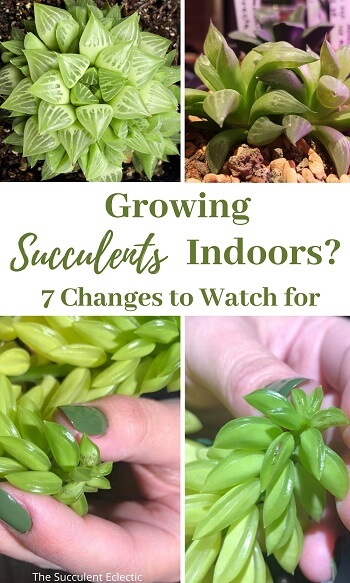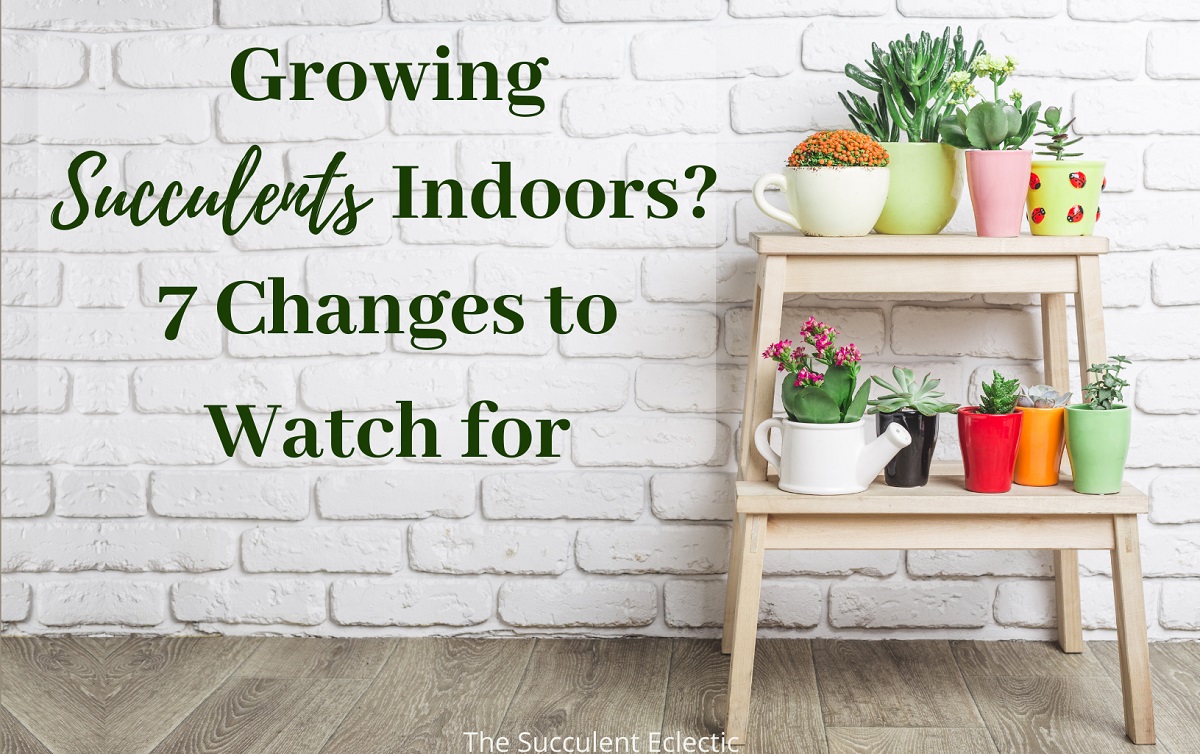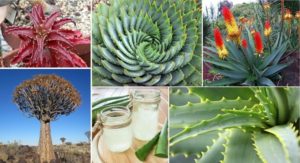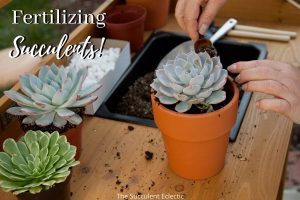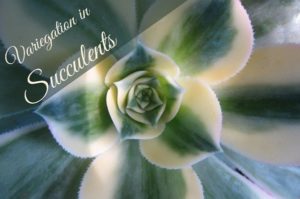Growing succulents indoors is absolutely doable, but there are challenges. When you bring succulents indoors either to protect them from winter’s chill or to grow them as houseplants, they experience dramatic changes in sun exposure, temperature fluctuations and airflow. Because each of these factors plays an important role in a succulent’s health, it is not surprising to see your plants go through some changes. Some of these changes look alarming, but should you be worried? Sometimes, these changes are totally normal, with nothing to worry about. But some changes are a clear signal that you need to adapt your succulent care. Let’s take a closer look at the changes you might see in overwintered or indoor succulents.
Changes you might be seeing in indoor succulents:
In this Post We'll Cover:
- Did your succulent change color?
- Are the succulent leaves drooping?
- Is your succulent leaning to one side?
- Are the leaves of your succulent stretching?
- Developing brown spots on succulents?
- Is your succulent growing root from stem?
- Fungus gnats on succulents?
Feel free to jump straight to the discussion of your succulent’s specific symptoms, but be sure to read the entire post at some time, to anticipate and prevent other issues!
{Please note, some links in this post may be affiliate links to sites that pay me a small commission if you click on the link and make a purchase. This commission is at absolutely no cost to you. I only recommend products and companies that I have worked with and truly love! ~Kat}
Growing Succulents Indoors
Indoor Conditions vs. Outdoors
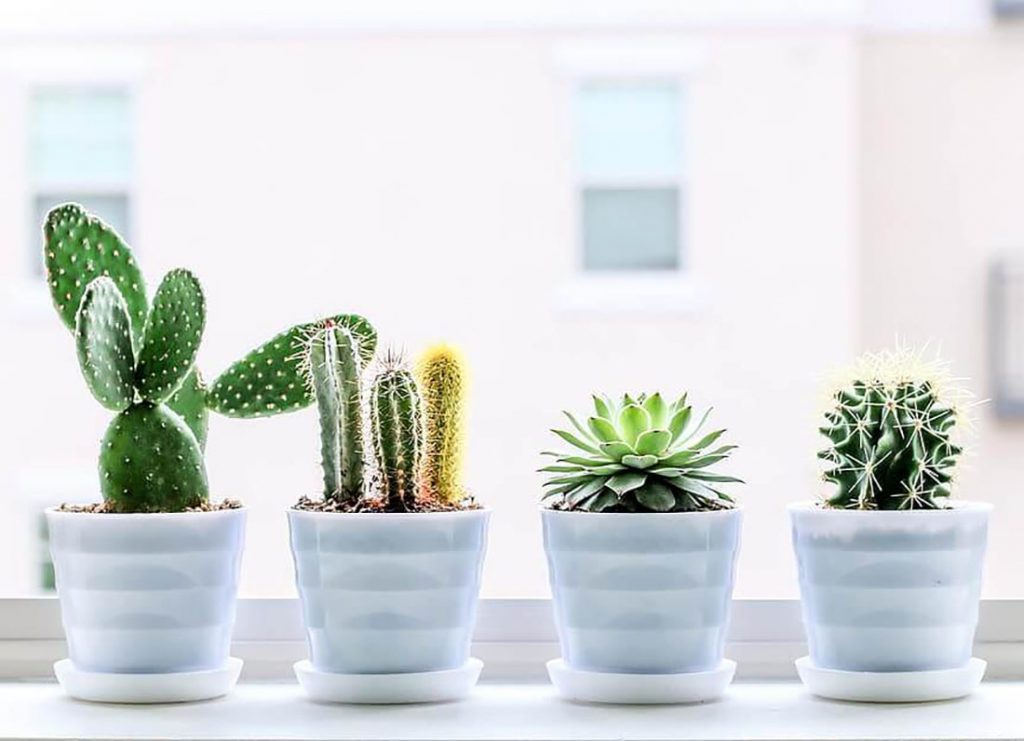
Whether you’re growing succulents indoors temporarily or for the long-term, you’ll need to adjust your succulent care. It might not seem like it, but indoor conditions are very different from outdoors. These differences are primarily light, temperature and airflow. The amount of light you can provide indoors will never be equal to what plants receive outdoors. Even right next to a large window, with sunlight streaming in, your succulent is not receiving “full sun exposure”. Modern windows cut out a great deal of the non-visible spectrum of light, to prevent upholstery and curtains from rapidly bleaching. While some succulents tolerate lower light than most, most succulents will do best with a grow light indoors.
You know it doesn’t get so hot during the summer or so cold during the winter for your indoor succulents. But think about the tremendous temperature swings plants experience outdoors from day to night and back again within a 24-hour period. Indoors, the temperature remains unnaturally consistent. Outdoors, wind, tiny breezes and these temperature changes keep the air in constant motion. Moving air increases a plant’s rate of transpirationTranspiration is the process of water movement through plant... More, and constantly provides a fresh source of oxygen. Still air indoors stimulates far less transpiration, so your plants use much less water. Cut back on your watering when you bring your succulents indoors, and try to boost the air circulation for them.
Succulent Change Color
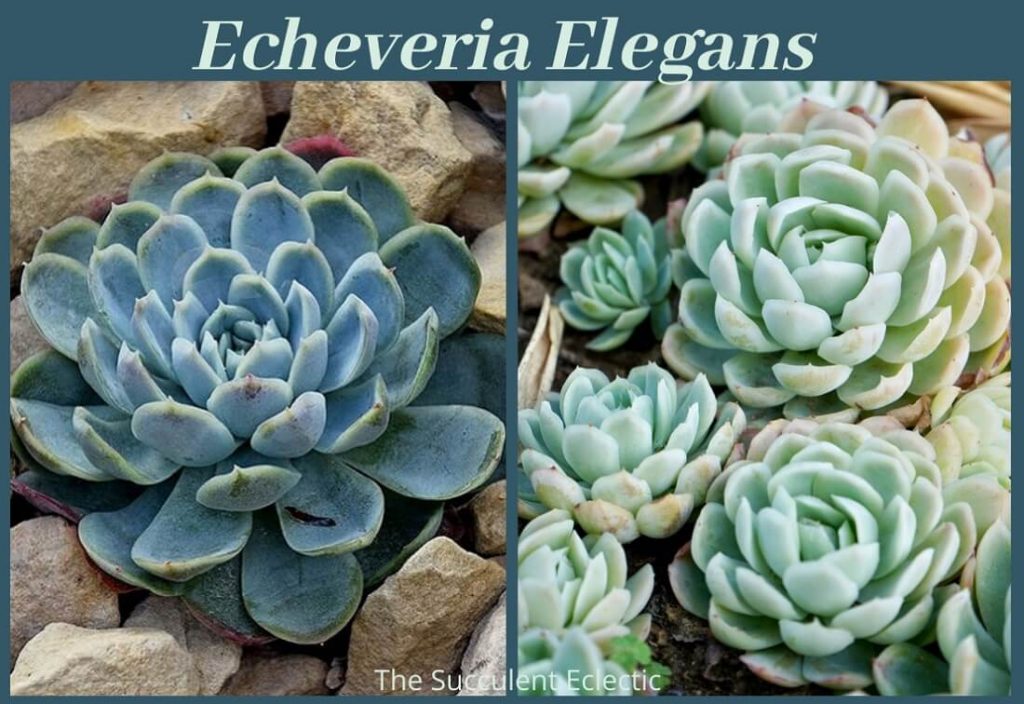
It’s so important to protect your tender succulents from freezing. So, you bring your succulents indoors over the winter. You give them as much light as you can, and all is well, right? Until, soon, you notice your favorite succulent change color! Rich blue succulents become pale and silvery grey. Vibrant red or yellow succulents turn green. They still seem healthy otherwise, but what’s the deal?
Some succulents develop brightly colored pigments to protect them from heat, cold, sunburn or drought. These colored pigments make our succulents change color in response to environmental stress. However, when you overwinter succulents indoors, the temperature is neither hot nor cold, the light is much less intense, and you are likely more attentive to watering. So stressed succulents are more comfortable, and they stop making their protective pigments. Then, you’ll notice the succulent change color, from red to green, from blue to silver-grey. This color change is entirely normal and nothing to worry about. But remember this change when it’s time to move your succulents outdoors! They no longer have their protective pigments, so you must let them acclimate gradually to outdoor conditions to avoid damage like succulent sunburn.
For more colorful succulents while they’re growing indoors, maximize the light as much as possible, with the help of succulent grow lights. To learn all about how to choose then how to use them, investigate my guide to succulent grow lights. To skip to the chase, choose the largest fixture of white, full-spectrum LED or T5/T8 fluorescent grow lights you can. You won’t save money in the long run by getting a small, skinny light for your growing collection. Just ask me how I know! 🙂 Succulents that need high heat, a sharp chill or large temperature fluctuations to display their best colors, won’t improve much while indoors, but your grow light can bring out much more color.
Succulent Leaves Drooping
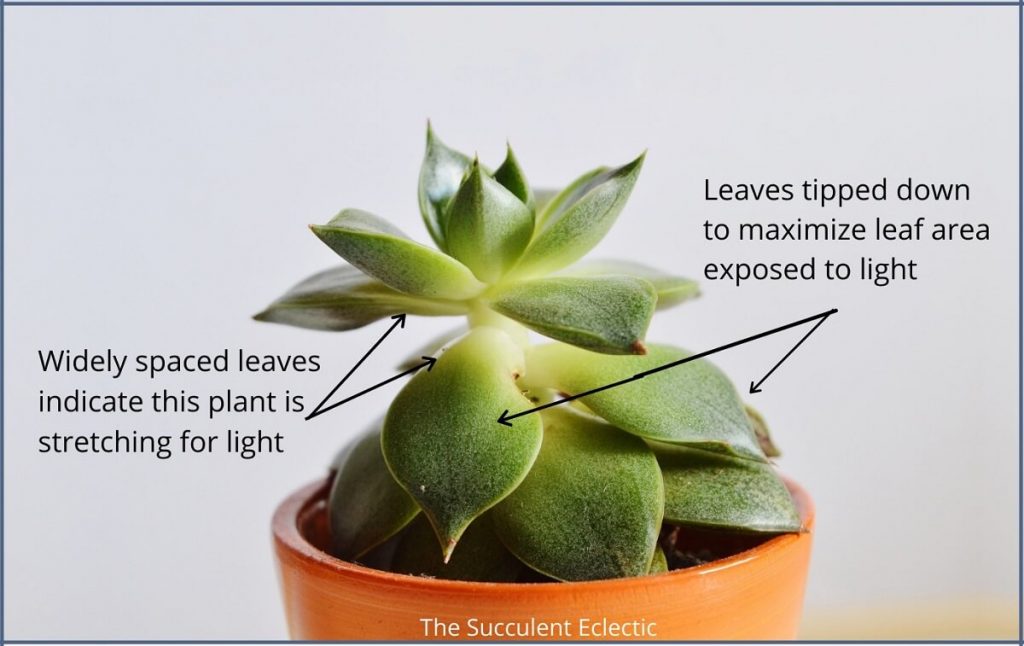
What does it mean when you notice your succulent leaves drooping? Before answering this question, we need to know first whether they are “drooping” or are they pointing down? Gently lift up on the tips of the leaves. If they move upward easily, but drop right back when you release them, they are truly drooping! Succulent leaves drooping that are a bit thin and limp, indicate the plant needs more water. There is insufficient water pressure in the stem, petioles and leaves to keep the leaves turgid (full of water and rigid or “perky”). Think of this a bit like a garden hose with just a trickle of water running through it. If you step on it or crease it, it collapses easily, right? But if you turn up the water volume, the hose becomes very full of water and stiff with the water pressure, or turgid.
However, what if the succulent leaves drooping resist your lift on their tips, and remain rigidly facing down? The resistance to your touch proves the plant is turgid and has sufficient water. Instead, the issue is that the plant is deliberately pointing its leaves downward in order to expose the greatest surface area of each leaf to the available light. This is the first sign that your succulent needs more light. Do what you can to increase the available light, from moving the plant closer to the window (be careful of a chill!), to adding a mirror to reflect the light back onto the plant, or by adding a succulent grow light.
When you have succulent leaves drooping, use touch to determine your succulent’s needs. You can learn a great deal about your succulent’s response to light by the position of the leaves.
Succulent Stretching, Leaning to One Side
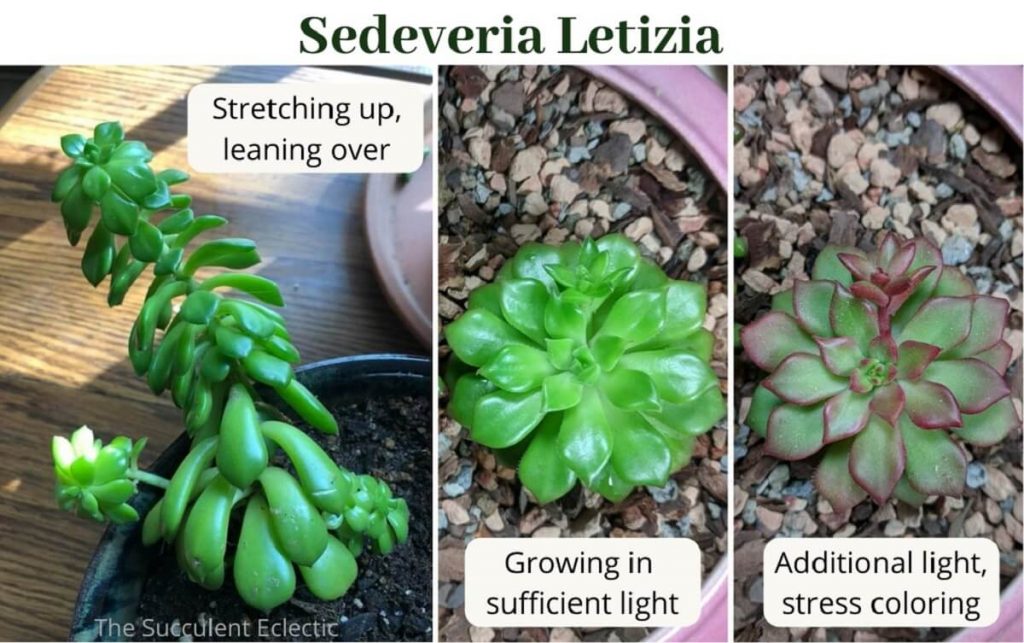
photo credit Emily Danielle Griffin and April Dailey
Another change you may notice with overwintered succulents is stretching. If your plant needs more light, and pointing its leaves down, as described in the previous section does not get it enough light, it will reach toward the light. Succulent stretching, or etiolation, allows the plant to put on new growth quickly, as it reaches for more light. Succulents will stretch upward, because they “know” the sun is up there, somewhere. But they will reach to the side, leaning over, in the direction of the greatest concentration of available light. A succulent grown in an evenly dark room stretches tall, you’ll see the succulent growing a long stem straight up, reaching for the sun. But if there is a window in the room that lets in some light, you’ll see the stretched-out succulent reaching in that direction.
With succulents growing indoors, it’s a good idea to give them a quarter turn every few days to keep their growth even and straight. But the only “cure” for a succulent stretching is more light. Move it closer to the window, add mirrors to reflect the available light back to it, or add a succulent grow light. As you can see in the pictures of Sedeveria Letizia, above, a stretched-out succulent looks radically different from another of the same variety grown with sufficient light. That compact, healthy growth habit can only be maintained with adequate light. Once the succulent has stretched, adding light will not cause it to contract. The tall, stretched stem will not shorten. But you can correct its growth.
Succulent stretching can be corrected by cutting back the elongated top growth and then rooting the stem cutting. When you do this, continue to care for the rooted base of the plant — it will sprout new top growth. And be sure to set aside any leaves you remove from the stem. You can propagate an entire succulent plant from a single leaf! Succulent stretching happens to every succulent grower, and certainly the first time you overwinter your plants indoors. Don’t despair! Look on it as an opportunity to brush up on your propagation skills! 🙂
Succulent Stretching its Leaves
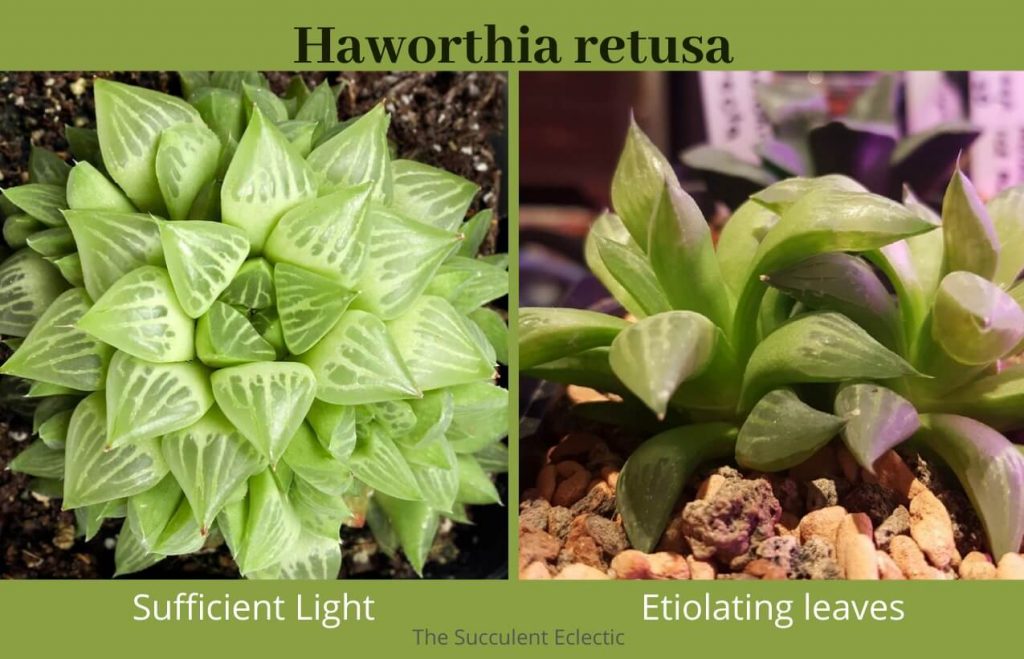
photo credit Mountain Crest Gardens and Khune Anne
Usually, when we see a succulent stretching, it is the stem that is quickly elongating. But what about succulents that have no stem or a very woody stem? In cases of stemless (or nearly so) succulents like Fenestraria, Haworthia, Lithops, Sansevieria or Sempervivum, where the stem cannot stretch, the leaves will stretch, growing longer to provide more surface area on each leaf to maximize the amount of light the plant can gather. This will also happen with succulents with woody stems that can not stretch quickly, like Aeonium or Portulacaria.
In the picture above, you see Haworthia retusa f. geraldi shown growing in plenty of light on the left, and with its leaves stretching for more light on the right. (Thank you, Khun Anne, for the use of this photo!). When succulent stretching elongates the leaves, rather than the stem of the plant, there is no easy fix, like cutting and propagation. Simply increase the amount of light* for the plant. With the right amount of light, new growth will be compact.
*Always remember to go slowly when introducing your succulent to more light outdoors. It is necessary to protect even full-sun succulents from sunburn when first introducing them to natural light.
Brown Spots on Succulents
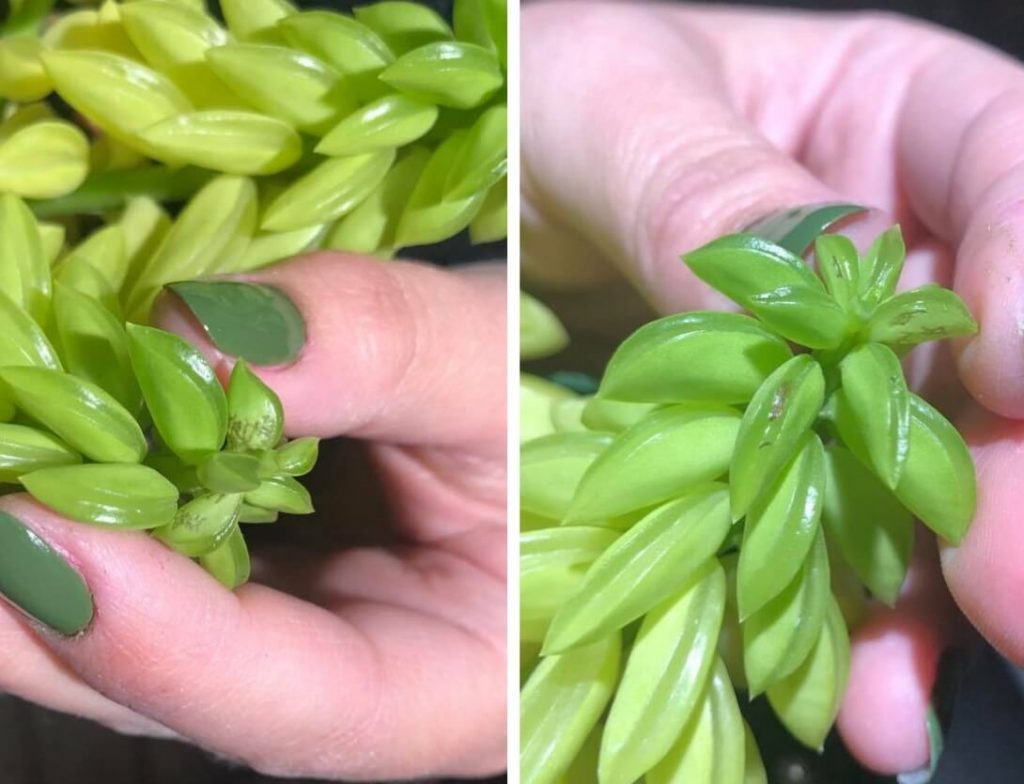
Are you starting to notice some brown spots on succulents that never had them before? Small, rough, sort of corky patches on the leaves that don’t wipe off? This is succulent edema, a disorder that shows up in the skin of a succulent plant. This occurs when the succulent is taking in water through its roots faster than it can release it back into the atmosphere through its leaves. EdemaIn plants, edema (eh-DEE-muh) is a condition caused when a p... More is not a disease. It is an early warning that your succulent care needs to be modified.
There are typically three main environmental conditions that lead to edema:
- Too much water in the soil
- Insufficient airflow
- Excessive fertilizing
It is not a surprise that overwintered succulents develop edema. Indoors, the airflow and available light are always much less than outdoors. It may take you a while to adjust your watering to accommodate these changes in your succulents’ growing conditions. If you find brown spots on succulents, cut back the amount of water you are providing, Be sure you are using a fast-draining succulent soil and a pot with good drainage. Increase the amount of light and improve the airflow around your plants. Be sure not to fertilize dormant succulents. If the light is low, don’t fertilize your succulents indoors at all, or you will spur faster etiolation.
Aerial Roots on Succulent Stems
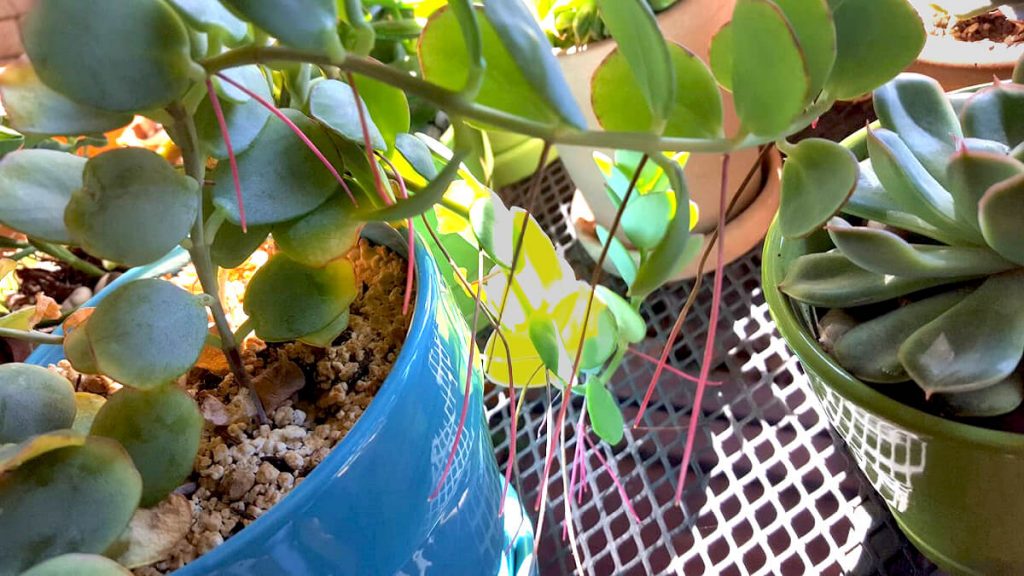
So, what does it mean when you notice your succulent is growing roots from it’s stem? These are succulent aerial roots, and they develop for pretty much the same reason normal roots develop — to supply the plant with water and to anchor the plant in place. Some varieties of succulents, particularly groundcover succulents like Sedum rubrotinctum, the Jelly Bean plant, nearly always have aerial roots developing throughout their life cycle. These plants grow with their stems running parallel to the earth, rooting in at frequent intervals. The aerial roots are seeking the soil, to root in and anchor the plant and supply it with water.
But what about aerial roots on succulent plants that grow upright, like the Kalanchoe above? Anytime a succulent becomes top-heavy, or a side branch reached out too far to support itself, or a succulent stem is etiolating and becoming weak, you will see aerial roots develop. They are a sign the plant feels a need for more support. So, too, will you see succulent aerial roots develop when the plant is consistently short of the amount of water it would ideally have. This does not mean that a thirsty succulent develops aerial roots right away. But if a succulent experiences a short supply of water over a period of months, it will form aerial roots that can capture trace amounts of moisture in the air, from general humidity or fog, to supplement the moisture available in the soil.
In general, when you see your succulent growing roots from the stem, it is a sign that it is a ground cover succulent, it needs more support or it wants more water. Don’t just jump to giving ot more water. First, look to see if it is top heavy and in need of pruning, or if it is etiolating. If you are unsure whether you succulent is etiolating or it is just a variety that grows tall, the presence of aerial roots tells you it is likely stretching for more light. While you can simply clip back aerial roots without harming the plant, first look to correct the environmental issues that are causing the succulent aerial roots to develop.
Fungus Gnats on Succulents
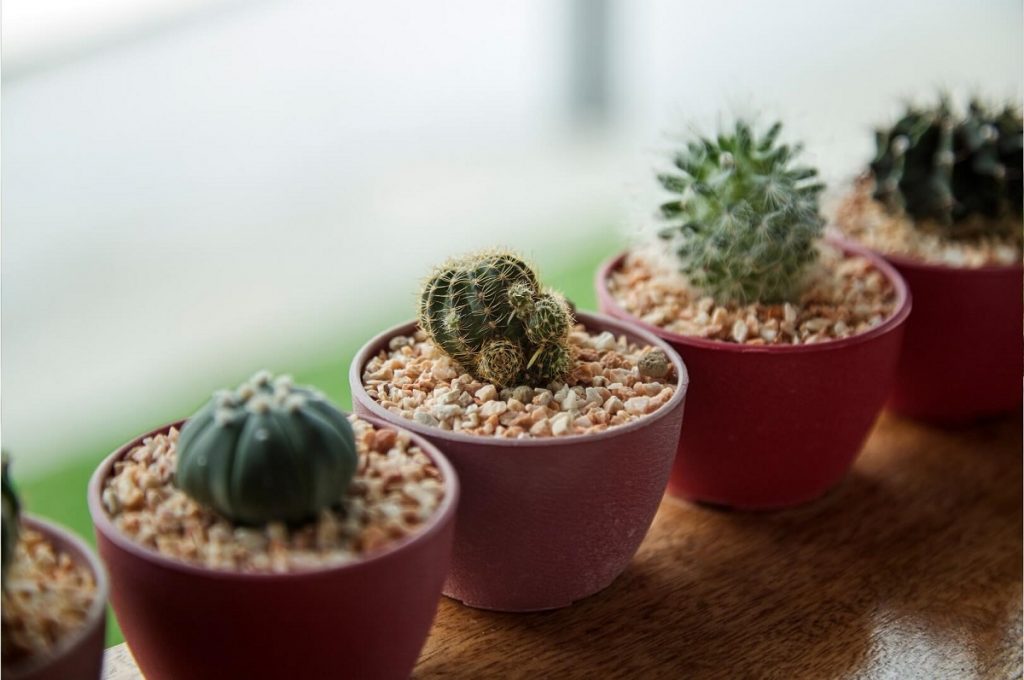
One change nearly everyone sees when they overwinter succulents or bring them indoors is tiny little brown gnats. These are fungus gnats, and they are not really a change, but something you only notice indoors. These tiny gnats are not feeding on your succulents but on minute bits of fungus found in wet, organic soil. Fungus gnats exist outdoors too, but they are very small, and cause no damage, so we typically don’t notice them outdoors.
Just because they aren’t feeding on your succulents is no reason to tolerate fungus gnats indoors. These gnats are an indication (with succulents) that you are a bit more generous with the water than you need to be. So, lighten up a bit on the water. You can treat fungus gnats with a spray of isopropyl alcohol, but they are always on the move, so this becomes an ongoing battle. There is a much simpler solution! Just apply a 1/3 inch layer of inorganic top dressing.
Top dressing for succulents provides a number of benefits, but what we care about here is that it breaks the life cycle of fungus gnats. These are very short-lived insects that lay their eggs in the moist soil. The adults cannot make their way through the 1/3 layer of inorganic top dressing, and hatchlings cannot reach the surface. Within 36 hours of adding the top dressing, the gnats will be gone! 🙂
Be on the watch for the changes in your succulents grown indoors. Remember to do what you can to increase the light and airflow for indoor succulents, and cut back on your watering. If you have any questions, please leave a comment! I will get right back to you!
Because life is just better with succulents!
P.S. For more great succulent information, please subscribe to The Succulent Eclectic! I’ll send you my free e-course, 7 Steps to Succulent Success! Thanks!
P.P.S. Why not join my Facebook Group for succulent lovers? We talk about succulent care, propagation, succulent identification, and design. It’s a warm and welcoming group that would love to meet you!
